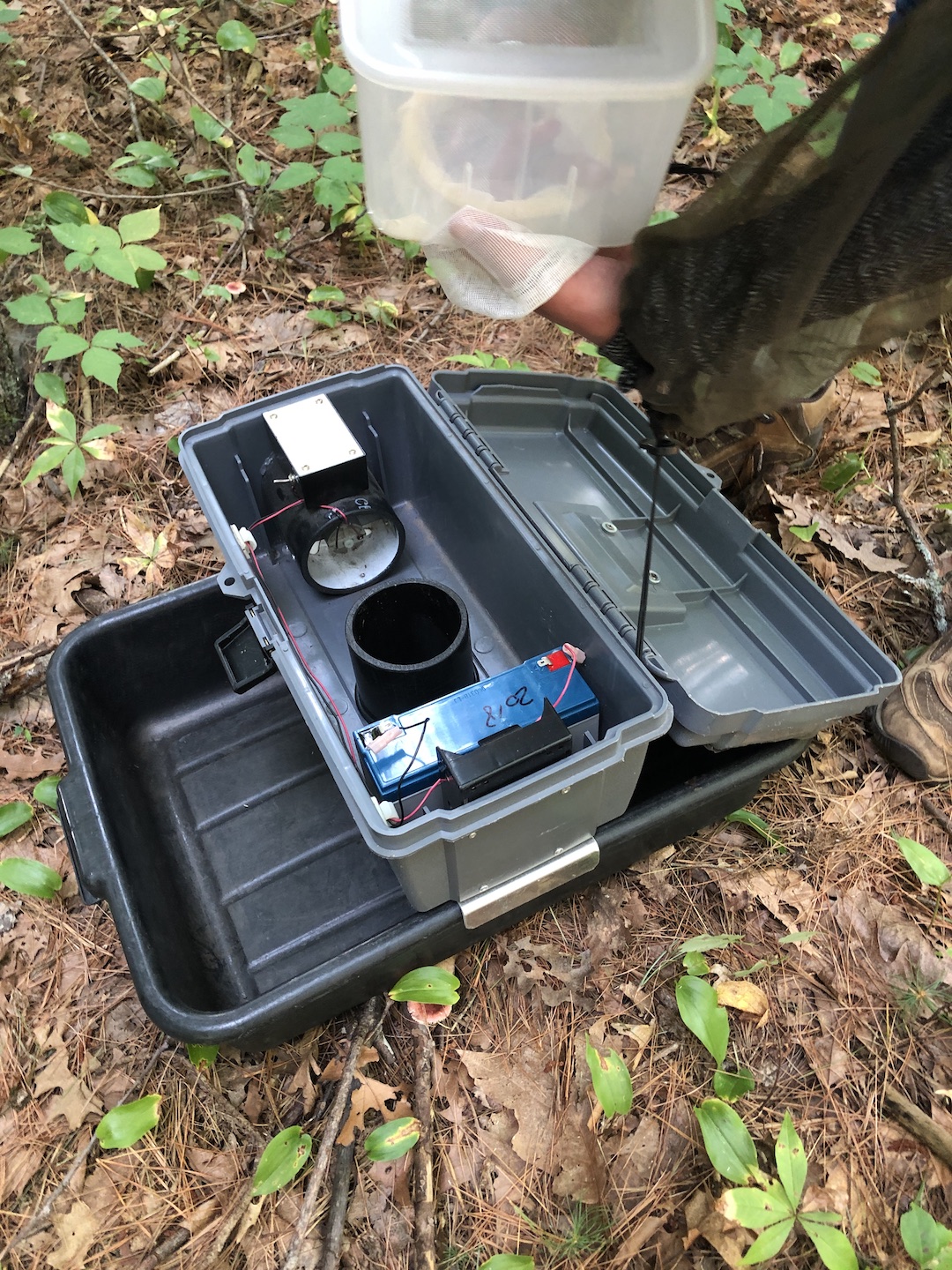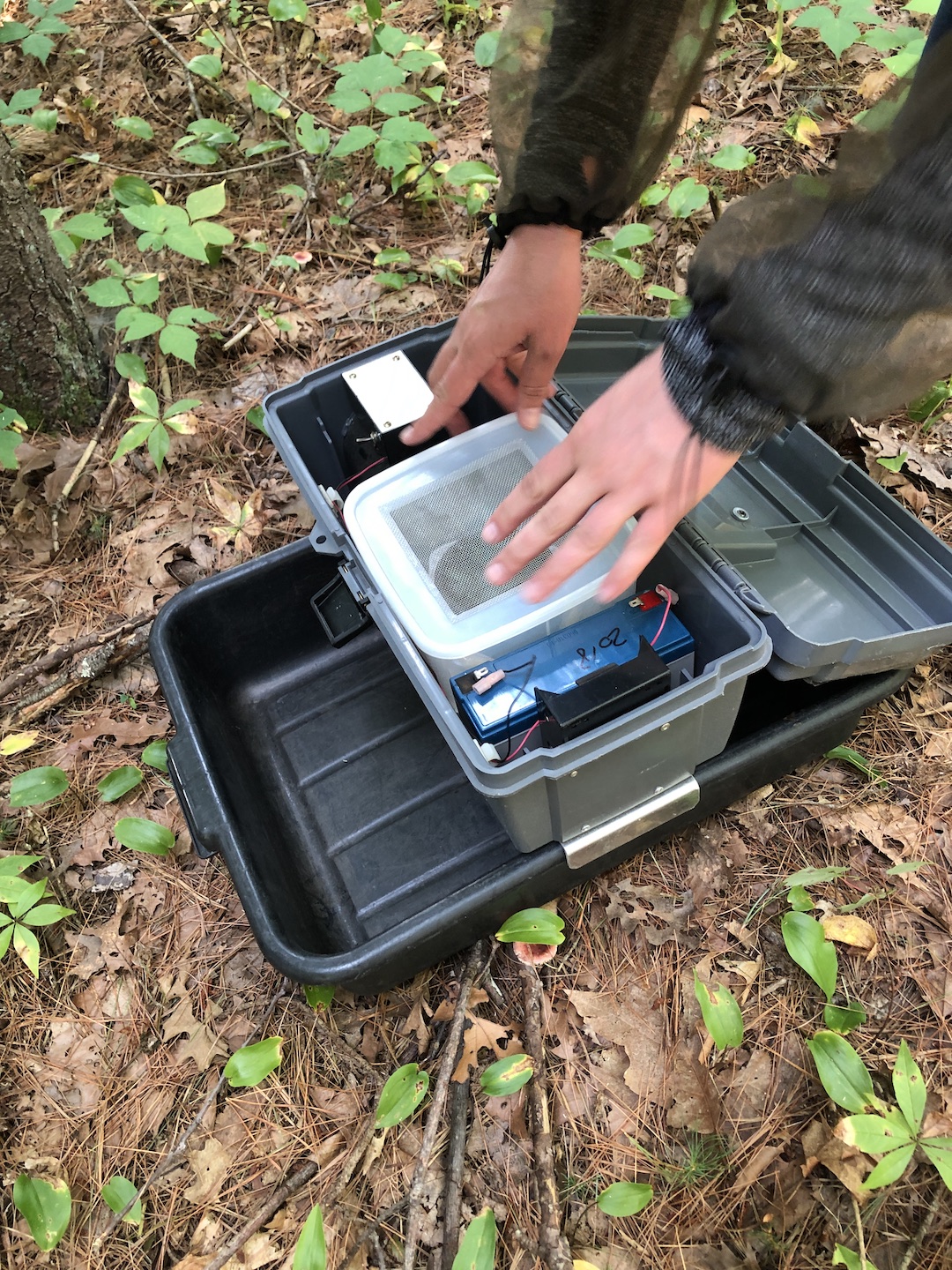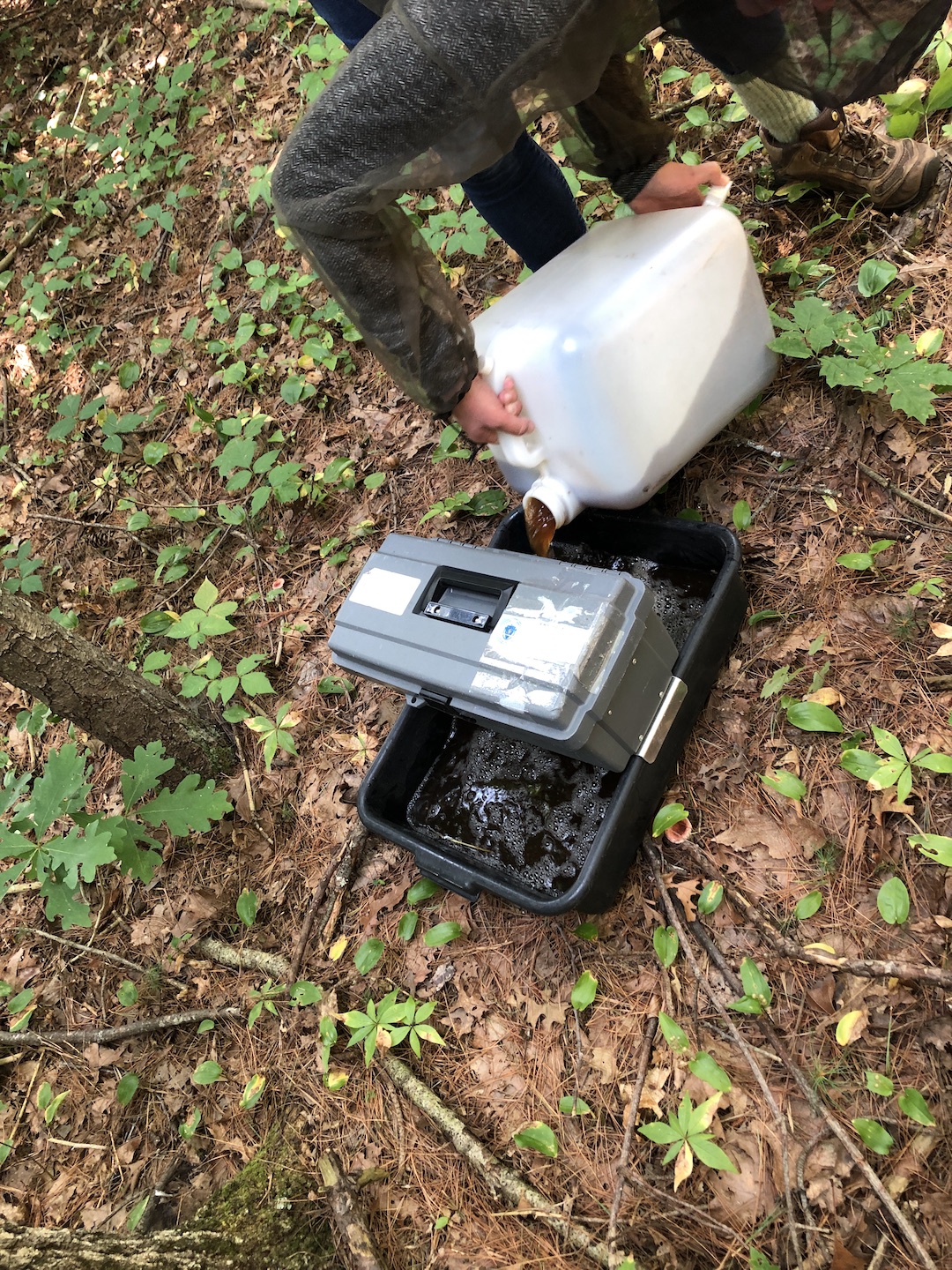Final Project Proposal
Project idea one: "Smart" chef knife and cutting board
I'm interested in using digital fabrication to create new designs for mosquito traps to improve field collection of specimens for viral disease surveillance (see idea two below), however, since new designs cannot be tested until mosquitos emerge in late Spring, for my final project I propose something entirely different: a smart cutting board and chef knife.
Motivation
Self-tracking and the notion of a "quantified self" is a growing cultural phenomenon, with devices like FitBit, Apple Watch, and smart scales logging when we sleep, how we move, when our heart beats, how much we weigh, and more. The motivations vary, with some measuring for curiosity, and others to quantify attempted improvements to performance or health. With technology capable of logging so much of our daily lives, one space is under-addressed: the kitchen.
I like to cook, so I propose instrumenting a cutting board and chef knife in order to track how they move. This has the potential for a number of novel uses:
Capabilities envisioned
- tracking wear to the knife and cutting board
- either by time-of-use, aggregate number of slices performed, or some function of load seen
- helps ensure maintenance reflects actual usage
- detect "dullness" by logging when more force is required for slices than we expect
- provide guided step-by-step instruction on how to perform certain operations
- detect orientation, and use accelerometer to log trace of movement, gyro to trace orientation
- users can step through protocolized directions, with the system providing feedback about whether their movements have been performed successfully
- potentially commercializable for restaurant training applications
- tracking performance
- time to complete preparation of one item ("How long does it take me to mince an onion or julienne a carrot? Have I improved?")
Basic sensors
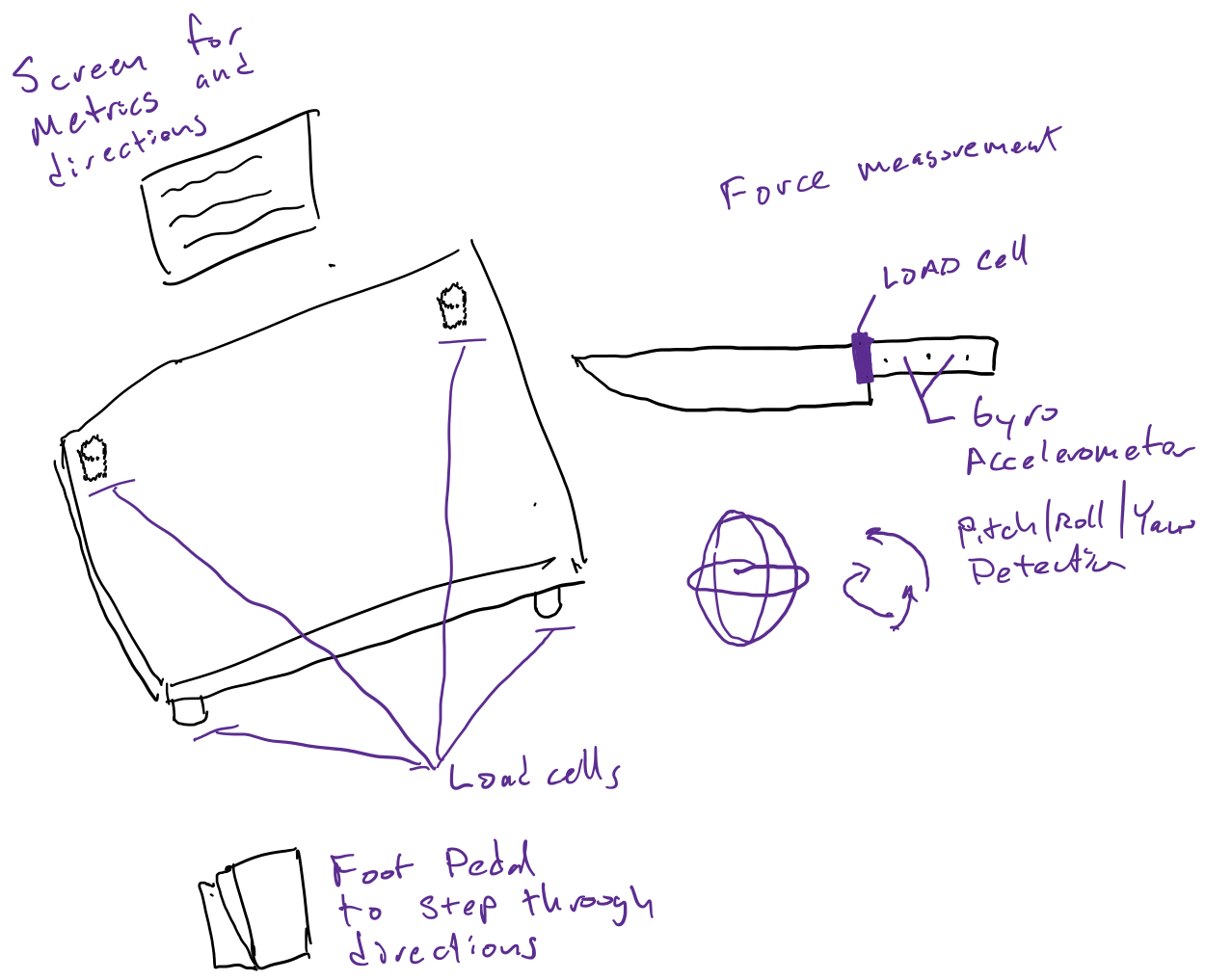
System diagram
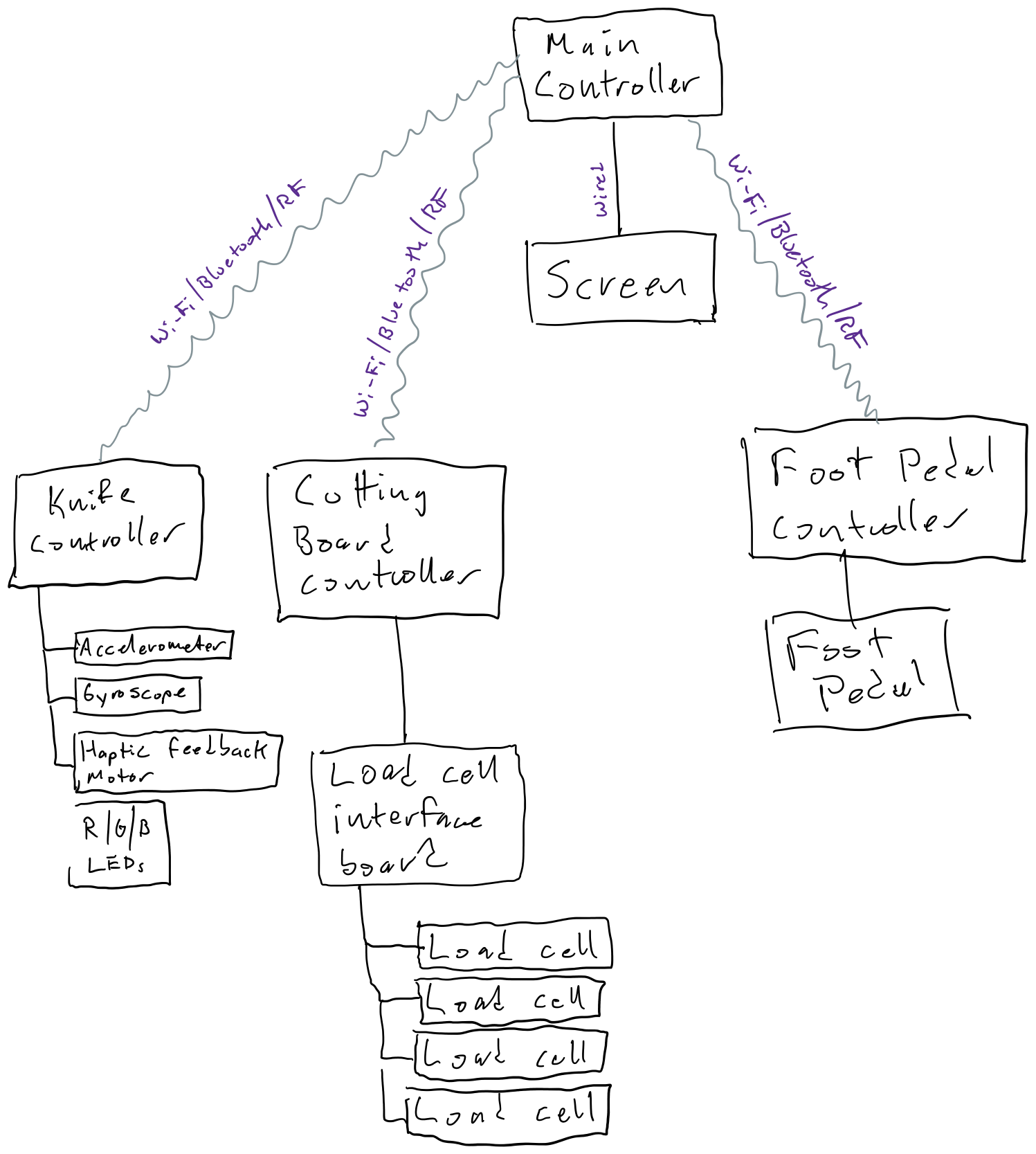
Mockup of system

Mockup of display
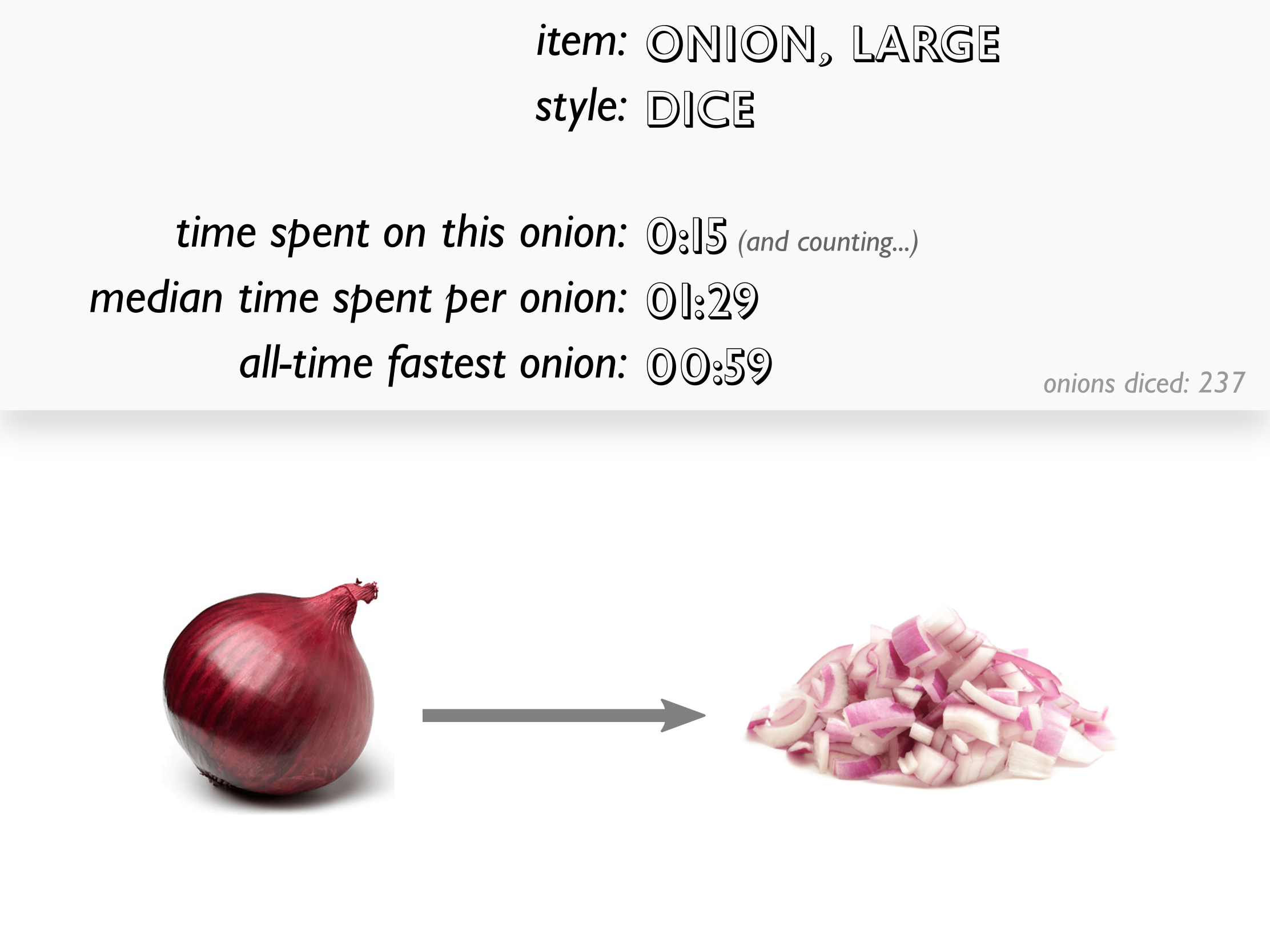
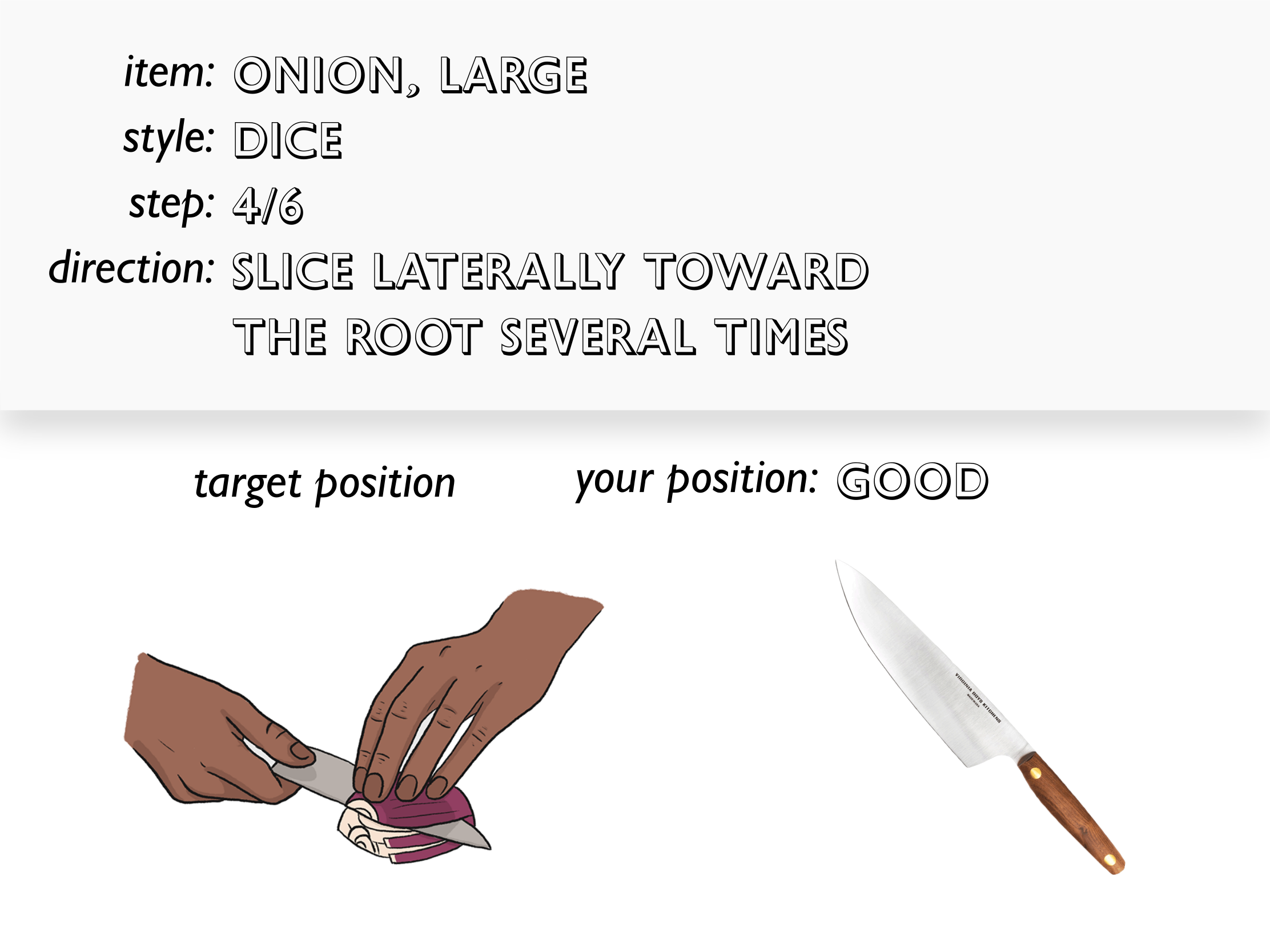
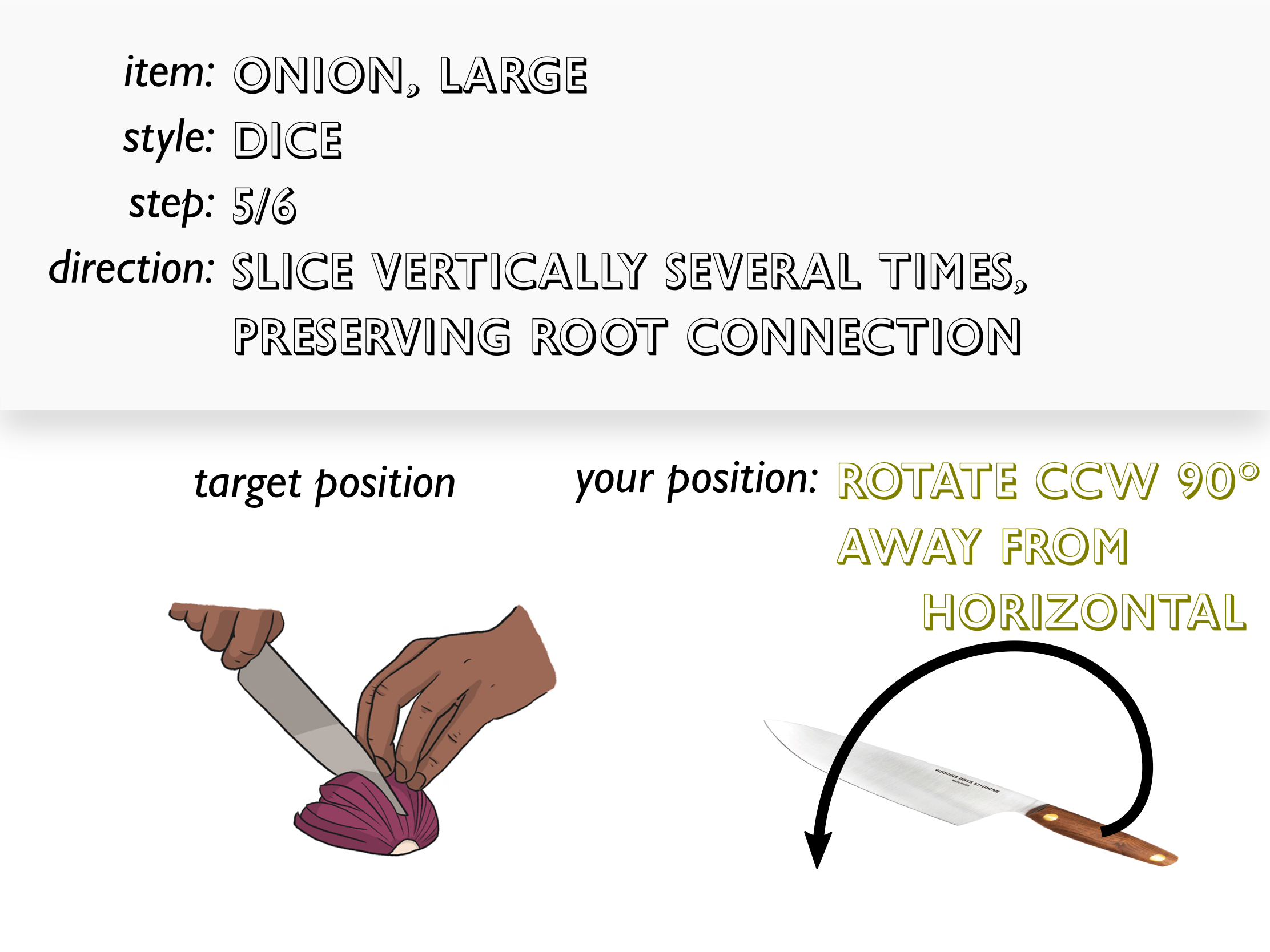
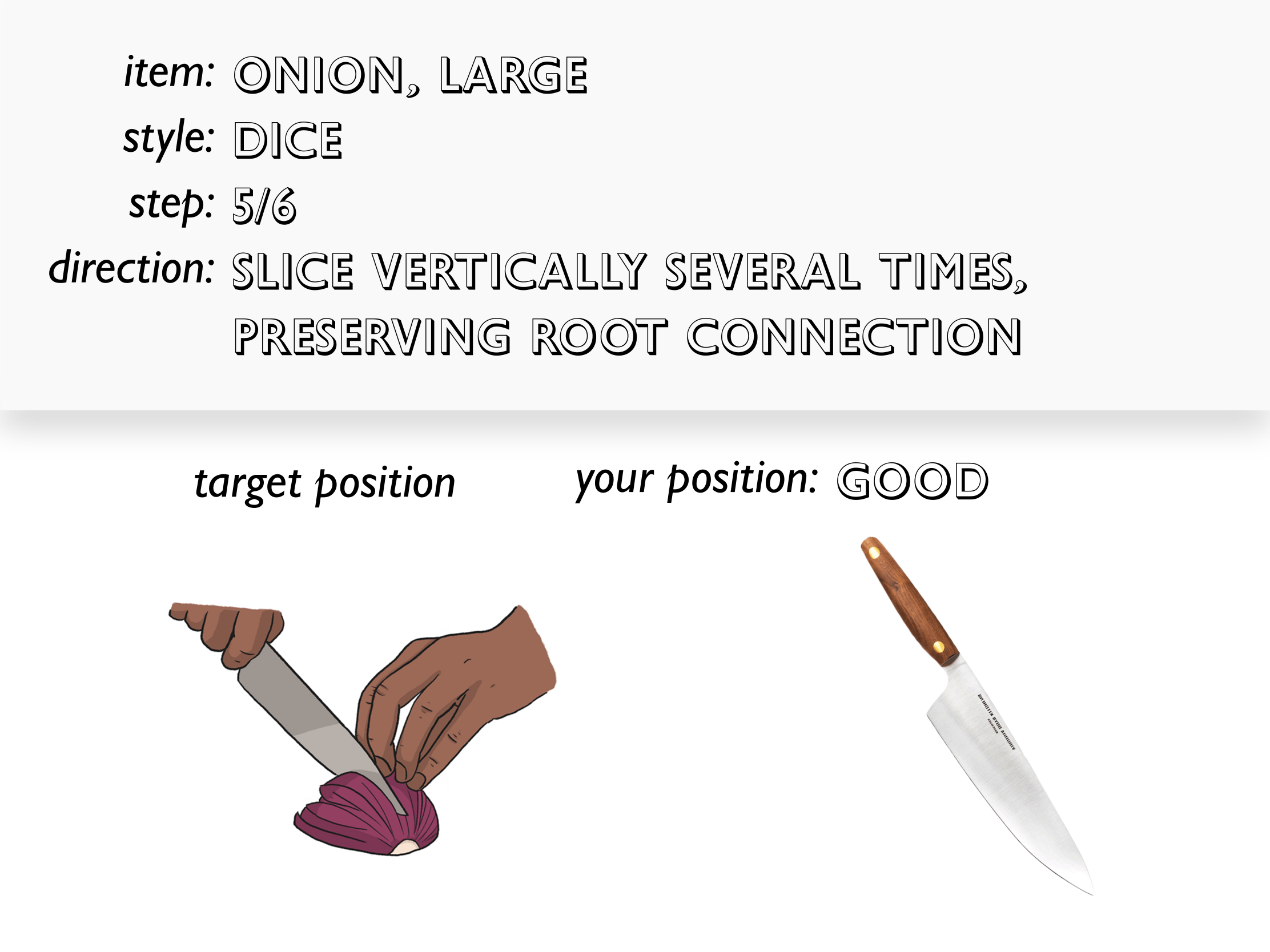
Onion illustrations from:
Other images from:
- https://www.readypac.com/wp-content/uploads/2016/04/Diced-Red-Onion-550x313.png
- https://images.freshop.com/7788881/9b79d3d211bfdc40883390e2ba5288ca_large.png
- https://s.yimg.com/ny/api/res/1.2/ew8PVg8sUbUy5Ft032EufQ--~A/YXBwaWQ9aGlnaGxhbmRlcjtzbT0xO3c9MTI4MDtoPTk2MA--/https://media.zenfs.com/en-us/purewow_185/9cc629888dc638f5be3fd1b730343162
- https://cdn.shopify.com/s/files/1/3008/1030/products/1.-Chef-Knife_2000x.png?v=1564613089
- https://s.yimg.com/ny/api/res/1.2/iQWtyT3WxQk5sq5uA3EOMg--~A/YXBwaWQ9aGlnaGxhbmRlcjtzbT0xO3c9MTI4MDtoPTk2MA--/https://media.zenfs.com/en-us/purewow_185/8f33bc6c73e4979c42160a1982af468e
Limiting project scope for PS70
Many of these application areas will likely require significant investment time to develop usable software and train mathematical models, so for this course I propose that the scope be pared down to include construction of the physical hardware, performance logging, and (if possible) detection of dullness.
Hardware required
The following hardware will be required:
- Load cells attached to the feet of the cutting board to measure force applied. This will approximate how they are used in a bathroom body scale at a smaller range of measure.
- Accelerometer and gyroscope in the knife handle to measure orientation and movement
- Load cell connecting the knife handle to the blade to measure force applied
- small buzzer/vibration motor for haptic feedback in knife
- COTS cutting board, wood preferred to allow recesses to be milled to accommodate circuit boards
- COTS kitchen knife with handle that can be easily removed
- small Li-Po battery for knife
- battery pack for cutting board?
- foot pedal to step through instructions
- radio modems (bluetooth? wi-fi? other RF?) to communicate between components
- small LCD screen for readout, debugging, and user instructions
Connection to course topics
This project will make use of the following course topics:
- Laser cutting
- Blade surrogates can be laser cut inexpensively out of plastic or wood before modifying COTS chef knives
- Construction of front panels for electronics enclosures
- Arduino Programming
- sub-components or supervisory components may be driven by an Arduino
- 3D design
- Clay impressed with a user's hand can be scanned via photogrammetry and used to model custom handles
- design of fixtures, enclosures, and assemblies
- 3D Printing
- Construction of enclosures to contain electronics
- Creating forms for casting handles
- Electronic input devices
- load cells, accelerometers, gyros
- CNC Milling
- milling of recesses in cutting board for electronics, sealing plates
- Electronic output devices
- haptic feedback motors
- LEDs, screens, and other visual output devices
- Molding and casting
- handles out of epoxy resin or metal, using smoothed+painted forms created via 3D printing
- Networking and communication
- Coordinating components to communicate together over radio
- Project integration
- connecting components for the cutting board, knife, etc. Possibly with custom PCBs.
- Computer programming
- of the various sub-systems, systems for user instruction
Project idea two: Improved tools for mosquito collection
Motivation
Though small in size, mosquitos have outsized scale when considered for their role in spreading disease, the broad reach of their habitable range, and the diversity of specific member species.
Pathogenic mosquito-borne viruses have received attention from investigators in the context of public health, but the broader microbiome, and in particular the virome, within mosquito species in the Northeastern US remains understudied.
I will analyze high-throughput sequencing data from mosquito samples already collected across this region to survey the viral populations present, reconstruct their evolutionary history, and characterize the broader microbial ecology. Tiny flying syringes, mosquitos sample their local environment through their movement, breeding, and feeding practices, and have the potential to serve as valuable sources of data.
This data, accessible through genomic sequencing, includes information relevant to ecology and to public health. Metagenomic sequencing unlocks this information by disentangling the mosquito itself from the rich community of microbes present within, and those microbes external to the insect. Xenosurveillance of mosquito blood meals has the capacity to reveal circulating human pathogens.
From personal observation of field practices employed by state collection teams within the Commonwealth of Massachusetts (July 2019) and personal communication with Dr. Anthony Kiszewski at Bentley University (January 2020), as well as arbovirus surveillance experts Matthew Osborne and Timothy Lynam at the Massachusetts Department of Public Health(January 2020), current mosquito collection protocols can yield samples subject to microbial contamination and degradation. This has the potential to yield genomic sequence data that confounds metagenomic surveys or is insufficient for complete viral genome assembly. Opportunity exists to optimize field collection and the laboratory processing upstream of sequencing to yield cleaner and more intact samples.
Trap designs in use
In Massachusetts, collection of adult mosquitos in the field occurs via mosquito traps of several designs, most notably the Centers for Disease Control and Prevention (CDC) Carbon Dioxide and Light Trap [14] which is designed to capture mosquito species without targeted species specificity, and the CDC Gravid Trap which was designed to capture primarily Culex mosquitos [10].
Trap shortcomings and potential redesigns
In the CDC CO2 and light trap, mosquitos must pass through a spinning fan blades. Contact regularly occurs between the fan blades and mosquitos entering the trap, leading to a range of damage to each specimen, from mechanical insult and reduced lifespan to complete disintegration and aerosolized dispersal of blood meals throughout the trap interior. This action disperses any microbes present in damaged mosquitos across the entire collected pool and can contaminate the external cuticle of specimens in the collection net with microbes otherwise found internal to mosquitos. Endogenous nucleases may also be dispersed, potentially leading to degradation of free nucleic acids present. The Massachusetts Department of Public Health has also conveyed concern that dispersal of specimens within a trap has the potential to endanger field collection personnel if the mosquitos are harboring pathogenic viruses, with EEE highlighted as a select agent of particular concern. A redesign of the trap to place the fan outside the collection passage may mitigate this concern, either by relying on negative pressure from outside the collection net to draw in mosquitos, or by using circumferential fan ducts formed by additive manufacturing (“3D printing”) to introduce positive air pressure at high air flow rate from a fan located away from the trap passage. The least drastic alteration to the current trap design may simply be to use a fan with fewer blades. Other airflow revisions may consider other designs described previously; one trap type employed a “counterflow” design where the intake air column is also used to disperse CO2 and other attractants [7]. Another found upward air flow to be better for yield and bycatch exclusion by physically selecting for mosquitos and other light insects [18].
The fans present in both the CDC CO2 and Light Trap as well as the CDC Gravid Trap are typically operated continuously. Anthony Kiszewski relayed that in unpublished studies, mosquitos were found to avoid continuous air column flowing toward a trap, reducing collection yield. This effect was found to be mitigated by operating the fan in a pulsatile regime, with a 50% duty cycle and a period of approximately two minutes. Revised trap designs may employ this alternating fan operation, or alternate control functions such as sinusoidal speed control approximated via pulse-width modulation of the power.
In the CDC Gravid Traps deployed by Massachusetts and many other mosquito control organizations, a tray of fetid water to attract female mosquitos (primarily Culex) as they search for a body of water suitable for oviposition [10]. This water is likely to contaminate specimens with a rich microbial community. This water is a fermented infusion of 0.5kg of hay in 114 liters of water, with 5g of brewer’s yeast and lactalbumin added [10], and serves as a source of 1-octen-3-ol (“octenol”), a volatile organic molecule occasionally referred to as “mushroom alcohol” for the “earthy” and “musty” aroma perceived by human olfaction. In the natural environment it is naturally emitted in marsh ecosystems and is believed to signal and attract responsive mosquitos to sites suitable for oviposition. It has also been detected in respiratory emissions of ruminants and has been posited to promote feeding on these animals [5].
Direct electrical measurement of olfactory response in A. gambiae to constituent chemical components of human sweat has been used to identify molecules to be investigated as potential moderators of mosquito behavior, including attraction to or repulsion from humans[4].
It is believed that semiochemicals influence host seeking via host volatiles, oviposition via breeding site volatiles, sugar feeding via plant volatiles, and mating [16,17]. Among studied attractants with broad-spectrum appeal, most effective for collection yield are the molecule octen-3-ol, carbon dioxide gas, and ultraviolet light.
Light serves as an effective attractants for many insect species[12], with light intensity considered more important than wavelength [1]. Ultraviolet (UV) light has also been demonstrated as an effective and non-selective attractant for many insect species[12]; a trap using solely a combination of visible light from an incandescent bulb and ultraviolet light from light-emitting diodes (LEDs) operating at a wavelength of 361nm has been commercialized by the John W Hock Company (Gainesville, FL) {Focks:wc} for discreet collection by military disease surveillance teams. Revised CO2 and light traps may consider including inexpensive UV LEDs.
Female fed mosquitos land on the surface of water multiple times in such environments to assess suitability for oviposition. In CDC Gravid Traps, the fan pulls in mosquitos during this process. This contact with the fetid water is likely to transfer contaminating microbes to each mosquito. Additionally, any aerosols from the tray are likely to be drawn into the trap due to air currents passing over the surface from the collection fan. A potential alternative to the use of fetid water as an attractant is the use of a pure chemical attractant rather than fetid water; synthetic octenol has been previously demonstrated as an effective attractant[15], though catchment varies by species [16] and can be modulated by additional factors including CO2 and heat [6]. Heat significantly increased catch when combined with carbon dioxide and octenol [6] with nearly double the collection yield for some species (though lower for one). A revised trap design intended to minimize contamination from the fetid water may employ pure octenol as well as carbon dioxide, and possibly heat. Attraction to carbon dioxide has been shown to be dose-dependent within the range emitted by vertebrate respiration ([16]). CO2 is typically emitted from regulated tank sources, though dry ice is also used. Simple yeast cultures in sugar have also been evaluated as CO2 sources[11], though CO2 from yeast was found to be less effective than gas from tanks or dry ice, likely due to the lower dose produced by the yeast [9]. While CO2 from tanks is the most economical, dry ice has the potential advantage of creating a cold hypoxic environment if traps were redesigned to exploit this capacity. Directing collected mosquitos to an insulated vessel of dry ice would freeze-kill the specimens and hold them at a reduced temperature suitable for arresting or slowing thermally-moderated degradation. Supplementation with tank-supplied CO2 may still be necessary with dry ice as overall collection yield was found to be lower for dry ice than CO2 from tanks [8].
The CDC CO2 and Light Trap as well as the CDC Gravid Trap each collect relatively large pools of mosquitos that can numbering in the hundreds of specimens, or thousands during periods of high abundance. The standard pools screened for arboviral presence include fifty mosquitos. Larger pools allow for discrimination of specimens into separate study groups, such as distinct species, sex, physical integrity, or age strata. As most arboviruses are not vertically transmitted, detection in adult mosquitos is more likely in older individuals than newly-matured adults. In the EEE vector, Coquillettidia perturbans, screening to select older individuals can be performed by eliminating those parasitized by many mites as newly-emerged specimens have higher abundance of water mites of the genus Arrenurus [3]. Segregating specimens by sex may be useful for examining microbe transmission patterns. Although only female mosquitos are hematophagous, male specimens can still prove informative as microbes seen in males are likely to have been vertically transmitted. Sorting large pools of specimens can create different study groups, however added value exists in the large pools: temporal information. If the members of a large pool can be partitioned into separate groups on an automatic timer, microbial abundance can be correlated with those specimens or species present at a particular time of day. Traps with the mechanical capability for simple fractionation by time have been described previously [13]. Partitioning by time also reduces the chance that a subset of a large pool would be microbially contaminated by new introductions or prior arrivals. It may be possible to redesign traps to include a simplified partitioning mechanism driven by the same motor as the sample intake fan, using gear reduction to increase available torque and slow the change of partitions. The continuous rotary motion of the intake fan can be converted to intermittent motion with indexed position via a “Geneva drive” gear mechanism; a system employed previously for environmental sampling of soil samples [2].
-
Barr, R.A., T.A. Smith, M.M. Boreham and K.E. White, 1963. Evaluation of Some Factors Affecting the Efficiency of Light Traps in Collecting Mosquitoes. Journal of Economic Entomology, 56(2): 123–127 https://doi.org/10.1093/jee/56.2.123.
-
Brooks, P.D. and E.A. Paul, 1987. A new automated technique for measuring respiration in soil samples. Plant and Soil, 101(2): 183–187 https://doi.org/10.1007/BF02370643.
-
Corbet, P.S., 2011. THE RELIABILITY OF PARASITIC WATER-MITES (HYDRACARINA) AS INDICATORS OF PHYSIOLOGICAL AGE IN MOSQUITOES (DIPTERA: CULICIDAE). Entomologia Experimentalis Et Applicata, 6(3): 215–233 https://doi.org/10.1111/j.1570-7458.1963.tb00620.x.
-
Cork, A. and K.C. Park, 1996. Identification of electrophysiologically-active compounds for the malaria mosquito, Anopheles gambiae, in human sweat extracts. Medical and Veterinary Entomology, 10(3): 269–276 https://doi.org/10.1111/j.1365-2915.1996.tb00742.x.
-
Hall, D.R., P.S. Beevor, A. Cork, B.F. Nesbitt and G.A. Vale, 2011. 1-Octen-3-ol. A potent olfactory stimulant and attractant for tsetse isolated from cattle odours. International Journal of Tropical Insect Science, 5(05): 335–339 https://doi.org/10.1017/S1742758400008626.
-
Kline, D.L. and G.F. Lemire, 1995. Field evaluation of heat as an added attractant to traps baited with carbon dioxide and octenol for Aedes taeniorhynchus. Journal of the American Mosquito Control Association, 11(4): 454–456.
-
Kline, D.L., 2002. Evaluation of various models of propane-powered mosquito traps. Journal of Vector Ecology : Journal of the Society for Vector Ecology, 27(1): 1–7.
-
Morris, C.D. and G.R. DeFoliart, 1969. A comparison of mosquito catches with miniature light traps and CO2-baited traps. Mosquito News, 29(3):.
-
Oli, K., J. Jeffery and I. Vythilingam, 2005. A comparative study of adult mosquito trapping using dry ice and yeast generated carbon dioxide. Tropical Biomedicine, 22(2): 249–251.
-
Reiter, P., 1983. A portable battery-powered trap for collecting gravid Culex mosquitoes. Mosquito News, 43(4): 496–498.
-
Saitoh, Y., J. Hattori, S. Chinone, N. Nihei, Y. Tsuda, H. Kurahashi and M. Kobayashi, 2004. Yeast-generated CO2 as a convenient source of carbon dioxide for adult mosquito sampling. Journal of the American Mosquito Control Association, 20(3): 261–264.
-
Silver, J.B. and M.W. Service, 2007. Mosquito Ecology. Springer Science & Business Media https://doi.org/10.2307/j.ctv8d5t9q?refreqid=search-gateway:73a0af1d84c0873e431d168e282d9b20.
-
Standfast, H.A., 1965. A miniature light trap which automatically segregates the catch into hourly samples. Mosquito News, 25(1): 48–53.
-
Sudia, W.D. and R.W. Chamberlain, 1988. Battery-operated light trap, an improved model. By W. D. Sudia and R. W. Chamberlain, 1962.
-
Takken, W. and D.L. Kline, 1989. Carbon dioxide and 1-octen-3-ol as mosquito attractants. Journal of the American Mosquito Control Association, 5(3): 311–316.
-
Takken, W. and B.G. Knols, 1999. Odor-mediated behavior of Afrotropical malaria mosquitoes. Annual Review of Entomology, 44(1): 131–157 https://doi.org/10.1146/annurev.ento.44.1.131.
-
Takken, W., 2011. The Role of Olfaction in Host-Seeking of Mosquitoes: A Review. International Journal of Tropical Insect Science, 12(1-2-3): 287–295 https://doi.org/10.1017/S1742758400020816.
-
Wilton, D.P. and R.W. Fay, 2011. Air Flow Direction and Velocity in Light Trap Design. Entomologia Experimentalis Et Applicata, 15(3): 377–386 https://doi.org/10.1111/j.1570-7458.1972.tb00222.x.
CDC CO2 and light trap
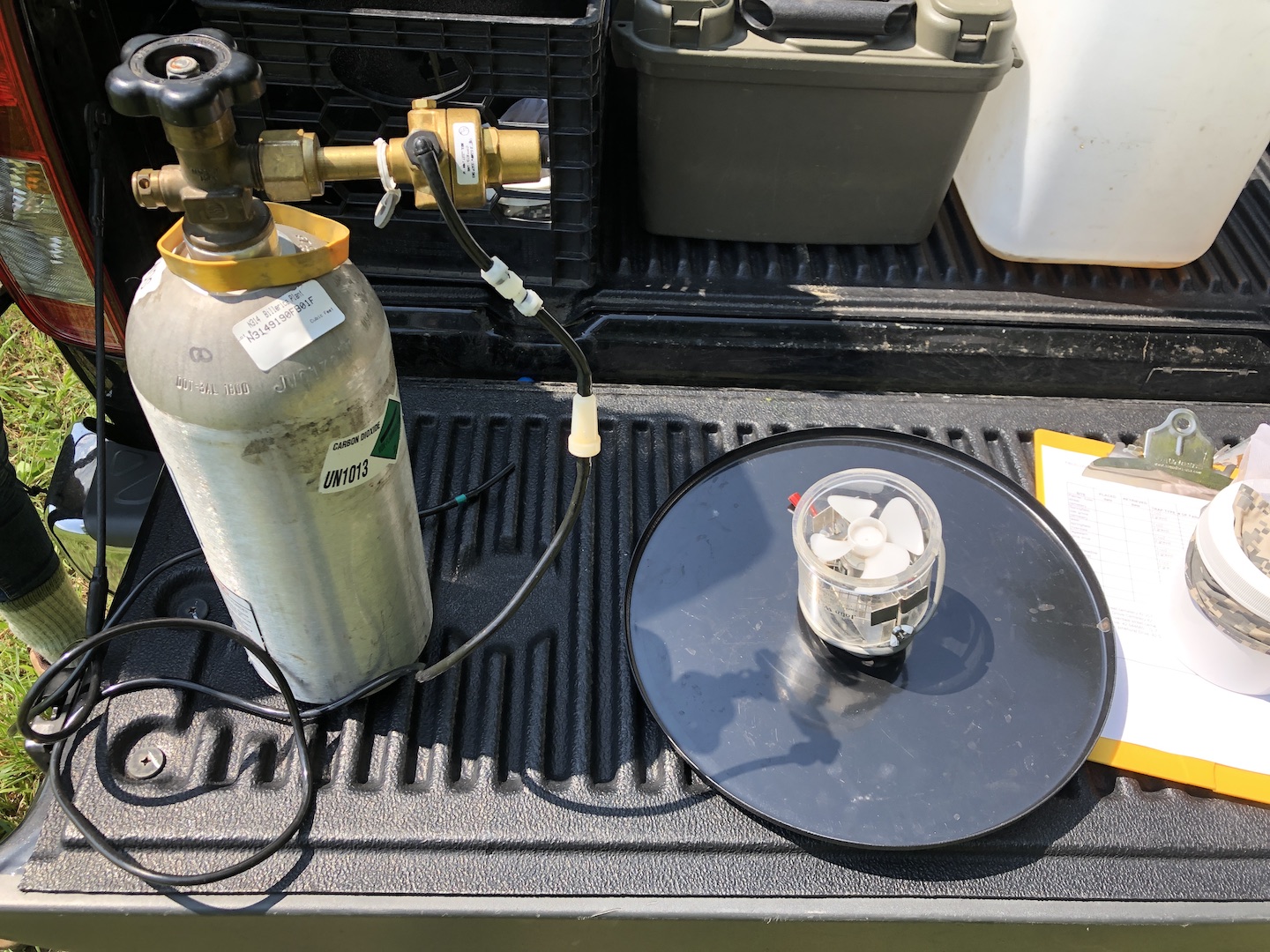
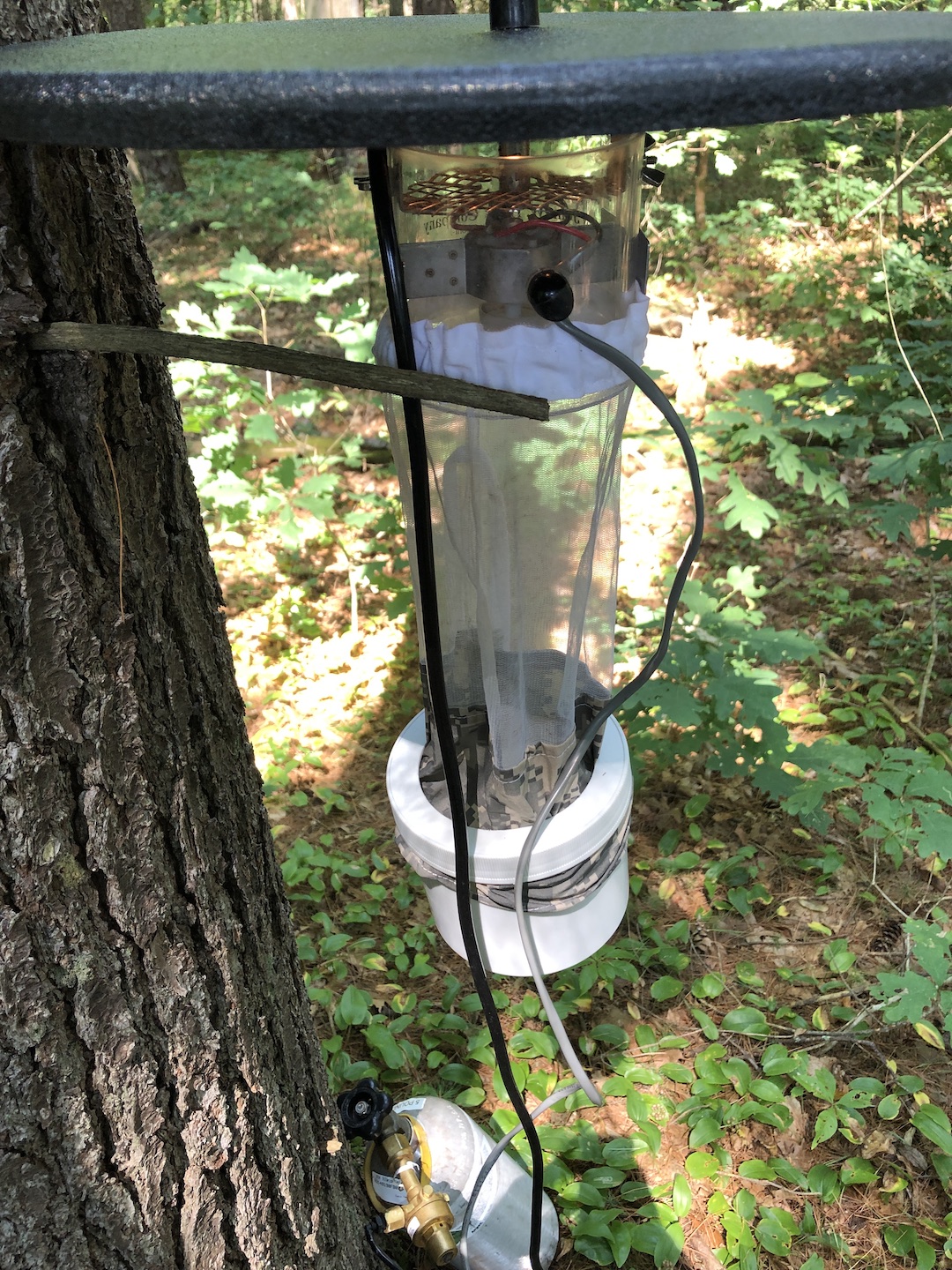
CDC Gravid Trap
